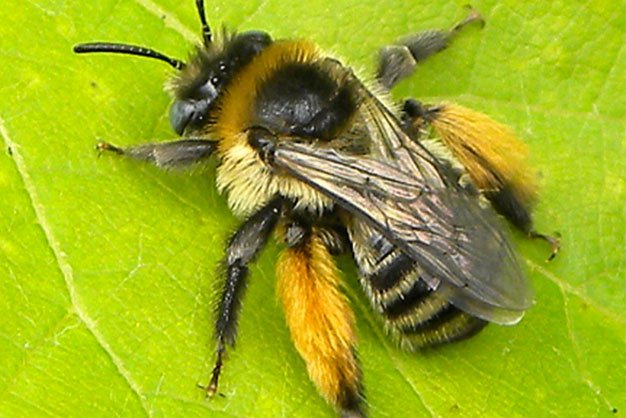
HONEYBEE (APIS MELIFERA)
The collapse of populations over the last decade has turned these familiar hive nesters into our proverbial canaries in the coal mine, but they’re not actually native to North America. Honeybees were brought over by European settlers and may be muscling out indigenous bees in some sensitive habitats. The honeybee is an essential pollinator for farmers across the continent, but budding beekeepers, take note: native bee expert York U prof Laurence Packer says we should be setting up “no fly zones” for honeybees near places like High Park to give wild bees some territory to do their thing.

MASKED BEE (HYLAEUS)
Toronto’s got a good dozen species of these largely black-bodied bees famous for their bright white or yellow face “masks” or triangular white spots, depending on their gender. Like over 90 per cent of wild bees, they don’t live in large social colonies and instead prefer solo living. These guys like nesting in dead, pithy bramble stems and hollow canes. Plant a raspberry bush against a bamboo trellis and they’ll be in heaven.

LONG-HORNED BEE (MELISSODES DRURIELLA)
The name says it all, but only one species is commonly found in these parts, according to the David Suzuki Foundation’s pollinator guide. Lay out a welcome mat by planting native asters, sunflowers and goldenrod. But like many wild bees, they’re ground nesters, so don’t smother every inch of your garden in compost or mulch, or cut your grass too short. Leave some bare, untilled patches of soil in sunny spots for these guys and other wild bees.

AUGOCHLORA PURA
Bicolour green-backed Agapostemon bees (Toronto’s unofficial bee mascot) are ground nesters that love to buzz around flowering shrubs as well as cone flowers and black-eyed Susans. Metallic green Augochlora pura are flower generalists that prefer nesting in soft, rotting wood. So don’t rake and bag all your fallen twigs for composting. Keep some sticks around the yard to make all sorts of wood-nesting pollinators a happy home.

BUMBLEBEE
Half of bumblebee species are in decline in North America because of exposure to pesticides, climate change and habitat loss. You may spot brown- or red-belted ones in Toronto, but others like rusty-patched and gypsy cuckoo bumblebees are near-impossible to come by in Ontario these days. Unlike some other wild bees that specialize in, say, evening primroses, bumblebees are flower generalists. But as a rule, native flowers will attract native bees, and exotic flowers will attract honeybees.
Find out, Are bee-harming insecticides hurting humans, too? here.
ecoholic@nowtoronto.com | @ecoholicnation












